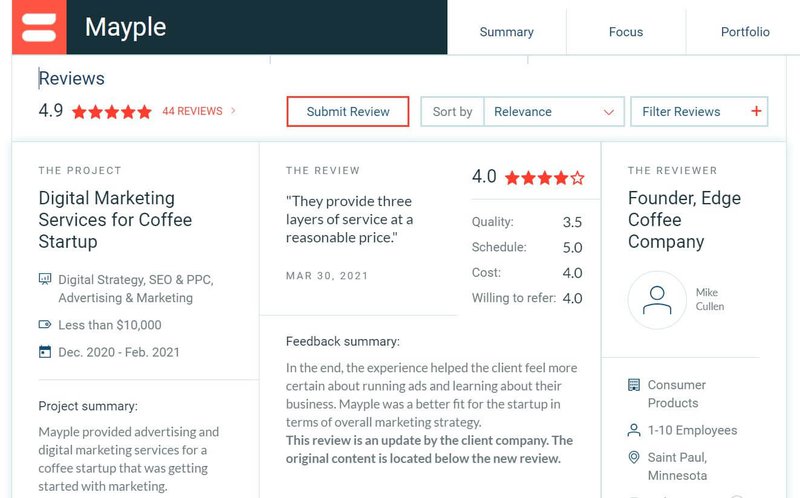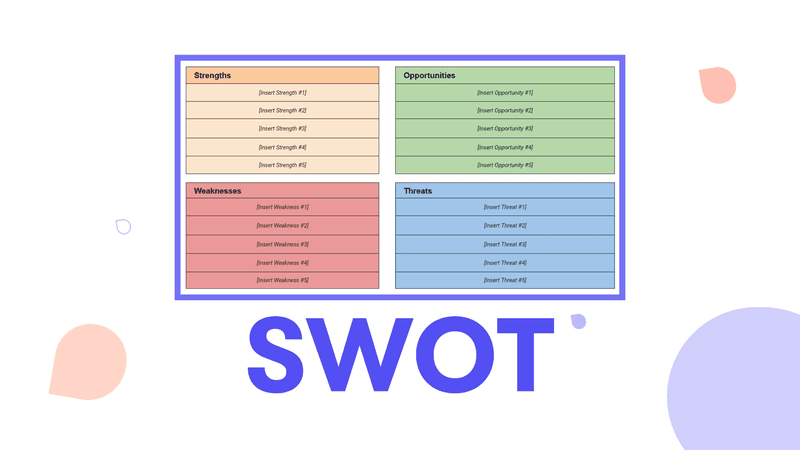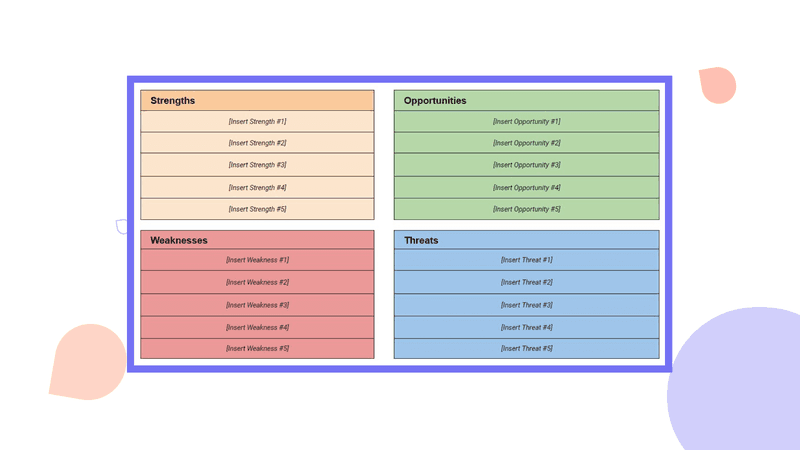Competitor Analysis: How to Spy on Your Competition in 2026 [Free Template]
A comprehensive guide on how to conduct a competitor analysis. Spy on your competitors by looking at their tech stack, marketing channels, pricing, and much more.
Updated November 7, 2024
![Competitor Analysis: How to Spy on Your Competition in {year} [Free Template] main image](https://entail.mayple.com/en-assets/mayple/635592ede551c61cc6cefd0a_austindistelwD1LRb9OeEounsplash11_ae2a6644f2663d2f32cd0295822bfbe3_2000-1699775590539.jpg)
Why did BlockBuster go out of business? Were they greedy? Did they fail to see the genius of Netflix when they declined to buy it for a measly $50M?
The answer is very simple. It’s not that they didn’t have a marketing plan. They didn’t spend enough time analyzing consumer preferences, and emerging technologies, and studying their competitors.
That’s what a competitor analysis is for (oops did I give it away in the title?).
So in this post, we break down what a competitor analysis is, provide a step-by-step process of conducting one, and give you a FREE template you can use to get a leg up on your competition.
Let’s dive in.
What is competitor analysis?
Competitor analysis is a process of gathering information about your competitors, their products, sales, and marketing strategies. The purpose is to understand their strengths, weaknesses, opportunities, and threats. This helps you to improve both your product and marketing strategy by comparing it with the strategies of other companies.
Competitor analysis can be useful for any business that's competing in a market where there are multiple players, which is 99% of all businesses everywhere. It's your chance to learn the ins and out of your competitors and how they do things, and identify potential opportunities where you can outperform them.
If you want to improve your bottom line or increase sales volume then competitor analysis is the first step toward the goal. But that's just one benefit of conducting this analysis, let's talk about the other ones.
Why do competitor analysis?
Identify your business's strengths and weaknesses
Conducting a competitor analysis helps you get an idea of where your business stands in the market.
- Are you lagging behind your competitors on certain features?
- Are you targeting the right audience?
- What are you missing?
- What are the biggest threats to your business?
- What are opportunities for growth?
Better understand your market
Another benefit of doing a competitor analysis is that you begin to understand your market better, and the best way to do that is by studying how other players are doing. You can find out what's working for them, what isn't, and how you compare in terms of performance. This will help you identify areas where you need improvement and help you find opportunities for growth.
Discover industry trends
An effective competitor analysis not only helps you identify the competitive landscape but also where the market is going. Successful business owners always keep their finger on the pulse of the market and try to spot industry trends before their competitors do.
For example, Starbucks is the leader in the market because of its innovation. It continues to expand to new product categories - sandwiches, alcoholic beverages, energy drinks sold in grocery stores, new technology, you name it.
Set benchmarks for future growth
Your analysis can help you get an estimate for the kind of future growth your business and the future performance of your various marketing channels. You should be looking for benchmarks in several areas:
- Benchmark your competitors' performance. Are they growing faster than you are? If so, how much faster? How many customers do they have and where are those customers located? How much revenue do they generate in each category of their business (e.g., e-commerce, retail stores)?
- Benchmark your own performance. How does your business compare with competitors when it comes to these indicators: website traffic, conversion rate, average order size, average order value, customer acquisition cost (CAC), churn rate, and lifetime value of a customer (LTV)? Are there any areas where you can improve based on what other businesses have done successfully?
How to do a competitive analysis
1. Determine who your competitors are
Direct competitors
These are businesses that directly compete with your product or service. They're in the same industry as you, have a similar business model to yours, target the same market segment and use similar marketing tactics to get there. Example: Starbucks and Pete's Coffee.
Indirect competitors
Indirect competitors are what are known as substitutes. It's when two or more businesses offer different products or services but compete for the same market. So for example, let's say you're a Starbucks, and right next to you is a McDonald's. If you went out of business, then more people would go eat at McDonald's. They are not direct competitors but they are a replacement or substitutes for each other.
Create a competitors matrix
Before you continue with the rest of the analysis it's a good idea to get organized. Get your list of competitors out and put them on a grid. You can put them on a bar graph or on a matrix with four quadrants.
Here's an example about Starbucks:
And here’s one we made for Mayple:
Gather background information
Once you have all your competitors organized, make sure to fill out some basic information on each one.
- Where are they located?
- What is their company size?
- What's the company's history?
- Who are their key customer personas?
Now it's time to get started with the action competitor analysis. To make it simpler, we're going to go through the 4Ps of marketing, which are - product, price, promotion, and place.
2. Find out what products your competitors offer
Now is your time to take a deep dive into your competitor's products and really see what product features they have and how those are different than your own offering.
Doing this part of the analysis can really help you learn about your competitor's target market, the kind of challenges they try to solve for their potential customers, and the kind of customer experiences they create.
3. Research your competitors' pricing strategy
Next, look at each of your competitor's pricing strategies. Here's what you should look for:
- What is the average selling price for a product or service in your industry?
- Is there one particular competitor that seems to be charging more than others or less? If so, why?
- How does your company compare with competitors on price?
- Are there any ways that you can improve your position relative to them on this front?
To learn more about efficient ways to research your competitors’ pricing check out our guide on competitor price monitoring.
4. Find out which marketing channels your competitors use
Here's our last P in the 4Ps - Place. Where do your customers sell their products?
You can find this out by looking at the types of ads they're running on social media, affiliate marketing sites, pay-per-click advertising like Google Ads, email marketing platforms (like Klaviyo or MailChimp), and content marketing programs such as blogs and websites.
You might also find other methods like public relations campaigns, and search engine optimization efforts, and if you're an eCommerce brand you should look for your competitors on other online marketplaces like Amazon, eBay, and Walmart.
The more you know about how your competition is reaching their audience with their marketing efforts the better equipped you'll be to create a winning campaign of your own. One of the best ways to do that is to use a competitor analysis tool like Similarweb that gives you a rough idea of all the various marketing channels and social networks your competitors use.
5. Look at your competitors' social media presence
A great way to find out your competitor's target audience is to look at the social media platforms they are posting on, and the type of content they are putting out. For each channel look at:
- Which social channels do they use?
- How many posts do they publish per week/month?
- How much engagement do they get?
- How many social shares do they receive?
- Whether they respond to every comment or not
- The types and formats of their content (video, infographic, slideshow, etc.)
- Do they work with influencers?
- Do they have user-generated content (UGC)?
- What's the ratio of organic traffic to paid traffic on their social channels?
For B2B brands, It's also important to look at the various employees of each competitor and see what they're posting on their own social media channels. This can give you an idea of the type of campaigns they're running and the strategies they're focusing on.
Once you get a sense of your competitor's social media strategy it's time to move on to their tech stack.
6. Study your competitors' tech stack
Tech stack refers to all the software components used by a company in their products and on their websites, and it's important to understand how your competitors' tech stacks work because it allows you to determine what they're good at. The tech stack includes things like:
- Database software (MySQL)
- Web server (Apache)
- Application framework (Ruby on Rails)
- Email marketing tools (Klaviyo, Mailchimp, Aweber)
- Marketing analytics (Google Analytics)
- CRM (Hubspot)
- Ecommerce platform (Shopify, BigCommerce)
You can use a tool like WhatRuns or BuiltWith to see all the various plugins that are present on all your competitor sites.
7. Research your competitors' content marketing strategy
A competitor’s content strategy is a great way to see what types of content they are producing, what their goals are, and how they use content to reach those goals.
- Does the company produce long-form articles or short-form blog posts?
- What’s the average length of their articles? How many words are in an article?
- What topics do they cover?
- Do they use images or videos?
- What's their publishing cadence (daily, weekly, monthly)
- Do they have an SEO strategy in place?
- Which organic keywords do they rank for?
- How much organic traffic do they get?
- How many external links do they have?
8. Find out the promotion strategy your competitors use around holidays & shopping days
It is important to know your competitors’ promotion strategies and if you're in eCommerce a big part of that is going to focus on holidays and shopping days. Look at the various promotional materials they've created for Labor Day, Thanksgiving Day, Christmas, etc. You can find most companies email campaigns on sites like Milled.
Promotion strategies can be based on price promotions such as price reductions, free gifts with purchase, or based on a percentage off.
9. Look at your competitors' customer reviews
Customer reviews are a great way to learn about your competitors, and they're easy to find on social media or other online forums. Look at the types of customer sentiment each brand gets—is it mostly positive? Negative? Are there common complaints or praises that pop up in multiple reviews?
When you read competitor customer reviews, you can learn a lot about the kind of customers each brand attracts, what their strengths and weaknesses are, and which features users love (and hate).
You can also use this information as inspiration for your own offerings—if another company's product has a feature that customers really love, try adding it to yours!
10. Perform a SWOT analysis
A SWOT analysis is a helpful competitor analysis tool you can use to structure your research. It's a framework that asks you to outline the strengths, weaknesses, opportunities, and threats of your own company and of all your potential competitors.
- Strengths and weaknesses: strengths are what your competitors do well, and weaknesses are where they could improve (internal factors).
- Opportunities and threats: opportunities for growth in their industry or market and threats would be anything that could hurt their business or make it difficult for them to compete (external factors).
Competitive product analysis
Perhaps the hardest part about doing a competitive analysis is comparing your actual product or service with that of your competitor.
There is often no industry standard, and the goalposts change, and that's especially true if you are operating in a less established niche. And if the differences aren't clear to your sales team they are going to have a hard time closing those deals.
So here's a step-by-step process of going about a competitive product analysis.
1. Compare product pricing
First, assess your current pricing. That's pretty straightforward.
2. Compare key features
Look at the specific features that your product has and the packages you offer. Compare your products to your competitors' and see which features you lack and which features you have an advantage in.
3. Pinpoint differentiators
Now dive deeper into the "why" behind these features. Why did each of your competitors develop their offerings? Who are they targeting? What is the challenge that they are solving?
4. Identify market gaps
Finally, put it all together and see where there are gaps in the market that could help you get ahead of the competition.
Get our competitive analysis template
Want to rock out your competitive analysis but don't know where to start? We've got an easy template for you that will help you get everything in order.
Click here to get our competitive analysis template.
FAQs
Why do competitor analysis?
It's important to do a competitor analysis to understand your competitor's strengths and weaknesses in comparison to your own, and see if there's a gap in the market that you can capitalize on.
Gathering competitive intelligence helps you identify your market share, develop better product features, and improve your digital marketing techniques, which should all lead you to improve your customer service and better reach your target customers.
When should you do a competitor analysis?
You should conduct a competitive analysis at any stage of your business. Just like before any big game, a good sports team should spend time studying their opponent. So companies should do the same.
A competitor audit is particularly important to do when you feel that the market or competitive landscape is changing, when there are a lot of new external factors (like a new competitor or new regulations), when you want to tweak your marketing or sales strategy, or get a better understanding of consumer behavior in your specific niche.
What is the meaning of competitor analysis?
Competitor analysis (also known as competitive analysis) is the process of identifying your competitors and researching their marketing strategies. You can use this analysis to identify your company's strengths and weaknesses, find new market opportunities and increase your market share.
How do you do competition analysis?
There are four key steps to every competitive analysis:
1. Identify your competitors. Look for brands that sell products in the same product category and target consumers with similar audience demographics.
2. Gather information about your competitors. Use competitor analysis tools to analyze the marketing channels, social networks, and social media strategy they're using and various sources of their organic traffic.
3. Analyze your competitors' strengths and weaknesses. Study your competitors websites, their performance metrics, their products, customer service, the type of customer experiences they create, and the consumer perception around their offerings.
4. Determine your competitive advantage. This is the final step of the analysis where you summarize your findings and present them to your team.
Is competitor analysis the same as SWOT analysis?
Competitor analysis is the entire breadth of research of the competitive market, at a high level. A SWOT analysis is a specific framework used as part of a comprehensive competitor analysis study.
Why do we do competitor analysis?
The purpose of conducting a competitive analysis is to understand your competitors' strengths and weaknesses relative to your own and to find gaps in the market. It can help you improve your business strategy, create better ways to reach potential customers, and get an edge over your competition.
What are the types of competitor analysis?
The types of competitor analysis include - SWOT analysis, the customer journey map, the growth-share matrix, Porter's Five Forces, business model canvas, sentiment analysis, and perceptual mapping.
There are other less-known types of analysis for SEO including a search competitor analysis and keyword gap analysis.
What are the objectives of competitor analysis?
The objective of competitor analysis is to study the changes in the market, and changes in supply and demand, and then adjust your business strategy accordingly.













